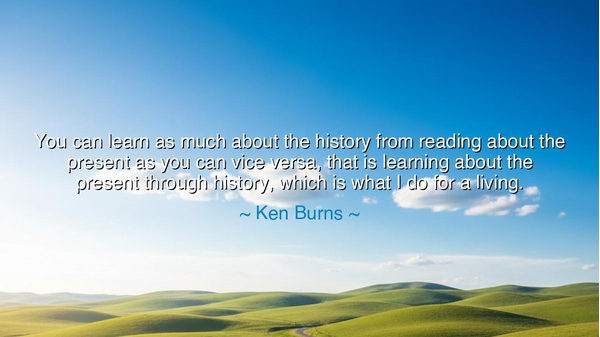
You can learn as much about the history from reading about the
You can learn as much about the history from reading about the present as you can vice versa, that is learning about the present through history, which is what I do for a living.






Ken Burns, the great chronicler of America’s stories, once spoke a truth both simple and profound: “You can learn as much about history from reading about the present as you can vice versa, that is learning about the present through history, which is what I do for a living.” His words are not merely about books or films; they are about the living fabric of time itself. They reveal that the past and present are not separate rivers, but one continuous flow, where the waters of yesterday and today mingle endlessly.
To learn history through the present is to recognize that the struggles, triumphs, and sorrows of our time echo those of ages past. Wars, revolutions, and renaissances may change in form, yet the same human heart beats within them all. Likewise, to learn the present through history is to understand that our choices, our conflicts, and our dreams are not born in isolation, but are the fruit of seeds planted long ago. Burns’ wisdom is this: one cannot be understood without the other.
The ancients knew this truth. Thucydides, writing of the Peloponnesian War, declared that his history would be “a possession for all time,” because he believed that human nature remains constant, and what happened once would happen again. In the same way, Ken Burns reminds us that when we gaze upon our own age—its politics, its culture, its divisions—we are reading not only the present, but also the echoes of the past. To read today is to glimpse yesterday, and to read yesterday is to see today more clearly.
Consider the example of Abraham Lincoln during the American Civil War. To many, his speeches were about the urgent struggles of the present. Yet he constantly drew upon the nation’s history, invoking the Declaration of Independence, the Founding Fathers, and the sacrifices of earlier generations. By using the past, he explained the present. And by reading his words today, we learn just as much about his century as we do about our own. Lincoln’s life itself proves Burns’ principle: the present and past illuminate each other like twin lamps.
Yet there is also humility in Burns’ statement: “which is what I do for a living.” It is a reminder that this is not abstract philosophy, but lived practice. Every documentary he creates is an act of weaving—the present eye looking back into the past, and the past speaking forward into the present. This humility is a teaching for us all: the work of connecting time is not reserved for historians. Each of us can practice it in our daily lives, by asking how the events we witness today are rooted in yesterday, and how they will shape tomorrow.
The lesson, then, is clear: never treat the present as isolated, nor the past as dead. Read the news with the eye of a historian; study the chronicles of history with the heart of one living in the present. Let each shed light upon the other. By doing so, you will not only understand your world more deeply, but you will also see your own life as part of a vast, unbroken story that stretches across generations.
So take this teaching with you: to learn from the past is wisdom, but to also learn from the present is insight. Bind them together, and you will see more clearly than those who look only one way. For the past is the mirror of today, and today is the heir of the past. Walk with both in your heart, and like Ken Burns, you too will live as a storyteller of time, guiding others with the light of understanding that spans the ages.






AAdministratorAdministrator
Welcome, honored guests. Please leave a comment, we will respond soon